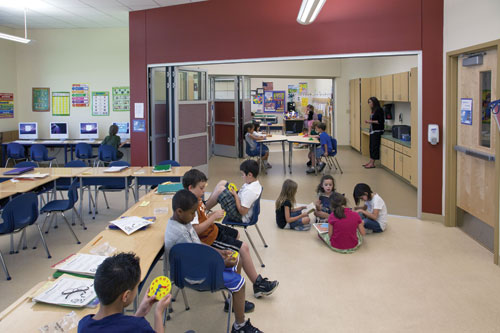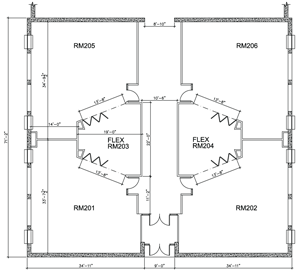First in Their Class: Innovative Design Solutions for Schools of the Future
Maximizing Space-Flexible Solutions
Multipurpose Classrooms
Although the benefits of multitasking have been disputed, the benefit of multi-occupancy in schools of the future continues to be a goal for educators. Seeking a means to provide environmental support for teaching methods that allow for active participation, self-direction and the clustering of different interest groups, educators are asking professionals to design facilities that maximize their use throughout a busy school day. Multipurpose rooms, per se, are not a new innovation, but using movable high-performance glass walls provides a new means to enhance classroom facilities.
 |
One of many configurations used by Burleson Elementary teachers in Texas. Photo courtesy of Nana Wall Systems, Inc. |
Case Study: Flex Space for Texas Schools |
|
When architects from SHW Group, Inc., of Dallas, Texas, met with the Texas Association of School Boards, they expressed interest in classroom flexibility for the new elementary schools being built in Texas independent school districts. At the direction of the Curriculum Director, SHW proposed an effective "flex space" concept that would give them maximum flexibility while reducing lab installation costs. Their challenge was to optimize and provide efficient use of limited floor space in schools, increase student learning and create a more enjoyable work experience for teachers.
Flex space was created in this school, by eliminating the common wall between two classrooms and installing two operable glass walls (see Diagram A). Configured in a V shape with a laboratory installation at the wide end, the space enclosed by the movable walls can be part of either or both classrooms. The teaching staff for the combined classroom can either monitor activities in all of the rooms or use the flex space to separate students for specific activities. They use this third space to provide alternatives in the classroom configurations. The walls have a horizontal mullion dividing the clear glass upper portion from the opaque, lower panel. When the pupils in the flex space are seated at their desks they are not distracted by the other activity in the other classrooms or by their classmates, yet the teacher can stand up and see both classrooms at once. The principals, teachers and students at the new Texas schools all agreed on the effectiveness of flex space created by movable walls to enhance the learning environment. The school board appreciated the cost savings incurred by dual use of resources installed in the flex space. Architect Konrad Judd, AIA, defined his experience with a flex space system in the Burleson School District as a vision for the future of school design as a means to provide "education delivery into the 21st century with a more flexible learning model." |










